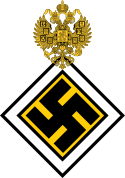
Back الحزب الفاشي الروسي Arabic Расійская фашысцкая партыя Byelorussian Руска фашистка партия Bulgarian Partit Feixista Rus Catalan Ruská fašistická strana Czech Russische Faschistische Partei German Partido Fascista Ruso Spanish حزب فاشیست روسیه Persian Parti fasciste russe French Orosz Fasiszta Párt Hungarian
You can help expand this article with text translated from the corresponding article in Russian. (January 2013) Click [show] for important translation instructions.
|
All-Russian Fascist Party Russian: Всероссийская фашистская партия | |
|---|---|
 | |
| Abbreviation | VFP |
| Secretary-general | Konstantin Rodzaevsky |
| Founder | Nikolai Nikiforov |
| Founded | 26 May 1931 |
| Dissolved | 1 July 1943 |
| Preceded by | Russian Fascist Organization[1] |
| Headquarters | Harbin, Manchukuo |
| Newspaper | Nash Put'[2] |
| Women's wing | Russian Women's Fascist Movement |
| Youth wings | Fascist Union of Youth[3] Union of Young Fascists – Vanguard Union of Fascist Little Ones |
| Membership | |
| Ideology | Russian clerical fascism[5] |
| Political position | Far-right |
| Religion | Russian Orthodox Christianity |
| Political alliance | All-Russian Fascist Party (1934)[8][9] |
| Colours | Black Gold White |
| Slogan | Бог, Нация, Труд ("God, Nation, Labour") |
| Anthem | Поднимайтесь, братья, с нами! ("Come up, brothers, with us!")[10] |
| Party flag | |
  | |
The All-Russian Fascist Party[a] (VFP),[b] and from 1937 onwards the Russian Fascist Union,[c] was a minor Russian émigré movement that was based in Manchukuo during the 1930s and 1940s.
- ^ E. Oberländer, 'The All-Russian Fascist Party', Journal of Contemporary History, Vol. 1, No. 1. (1966), pp. 158–173
- ^ The Russian Fascists: Tragedy and Farce in Exile, 1925-1945 by John J. Stephan
- ^ Русские фашисты в Китае
- ^ Center. archive of the FSB of the Russian Federation. Investigation case N-18765 in relation to Semyonov GM, Rodzaevsky KV and others T. 10, ld 145-206.
- ^ a b c d e Oberländer, Erwin (January 1966). "The All-Russian Fascist Party". Journal of Contemporary History. 1 (1): 158–173. doi:10.1177/002200946600100110. JSTOR 259654. S2CID 159295789.
- ^
Badie, Bertrand; Berg-Schlosser, Dirk; Morlino, Leonardo, eds. (7 September 2011). International Encyclopedia of Political Science. SAGE Publications (published 2011). ISBN 9781483305394. Retrieved 9 September 2020.
[...] fascist Italy [...] developed a state structure known as the corporate state with the ruling party acting as a mediator between 'corporations' making up the body of the nation. Similar designs were quite popular elsewhere in the 1930s. The most prominent examples were Estado Novo in Portugal (1932-1968) and Brazil (1937-1945), the Austrian Standestaat (1933-1938), and authoritarian experiments in Estonia, Romania, and some other countries of East and East-Central Europe.
- ^ Stephan, John J. (1978). The Russian Fascists: Tragedy and Farce in Exile, 1925-1945. New York: Harper & Row. p. 56. ISBN 0060140992.
- ^ Winter, Barbara. The Most Dangerous Man in Australia Archived 2016-04-25 at the Wayback Machine. Carindale, Qld: IP (Interactive Publications), 2010. p. 131
- ^ The Russian Fascists: Tragedy and Farce in Exile, 1925—1945 by John J. Stephan, p. 160
- ^ Anthem of the Russian Fascist Party "Flags up!"
Cite error: There are <ref group=lower-alpha> tags or {{efn}} templates on this page, but the references will not show without a {{reflist|group=lower-alpha}} template or {{notelist}} template (see the help page).